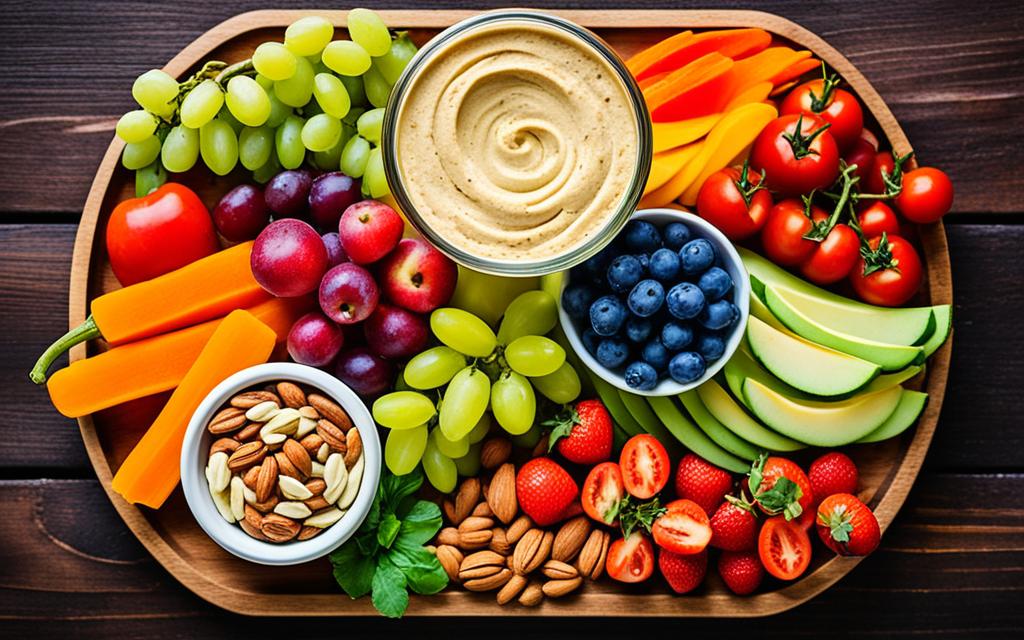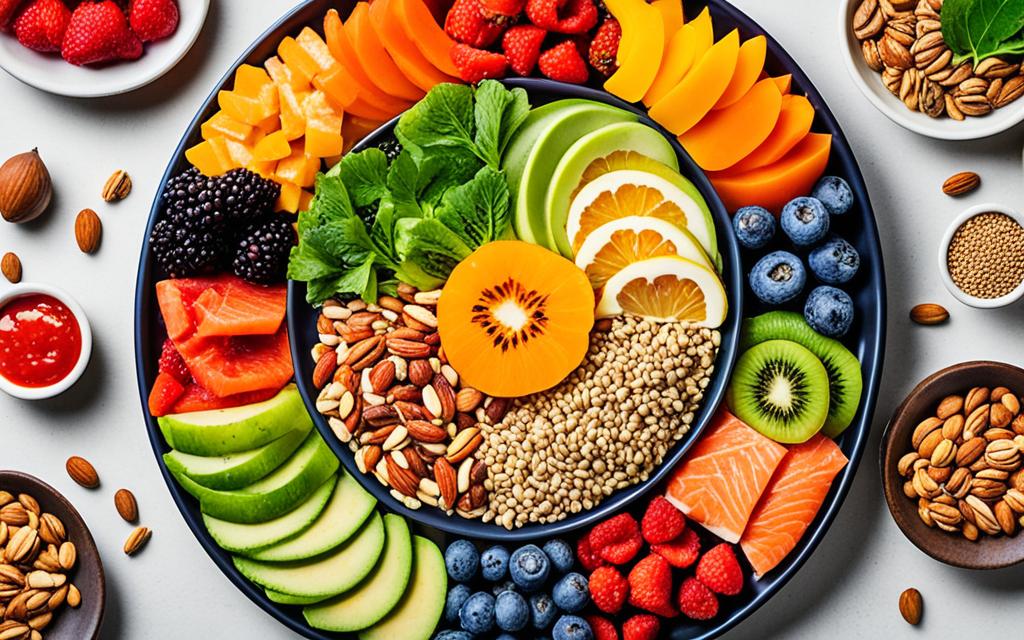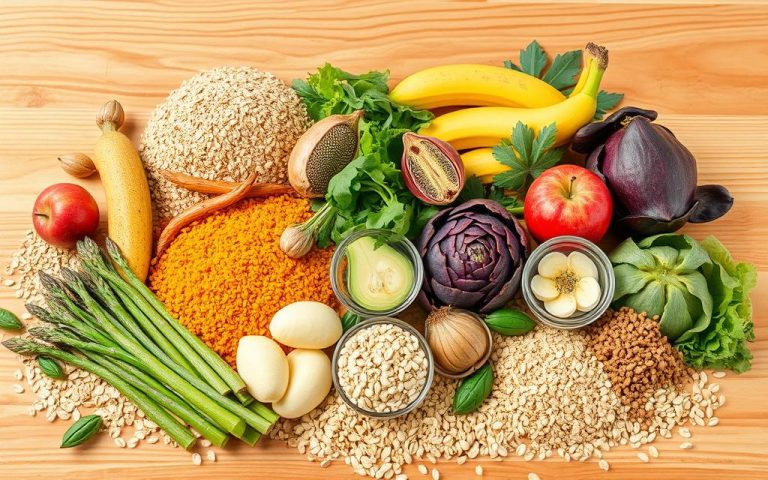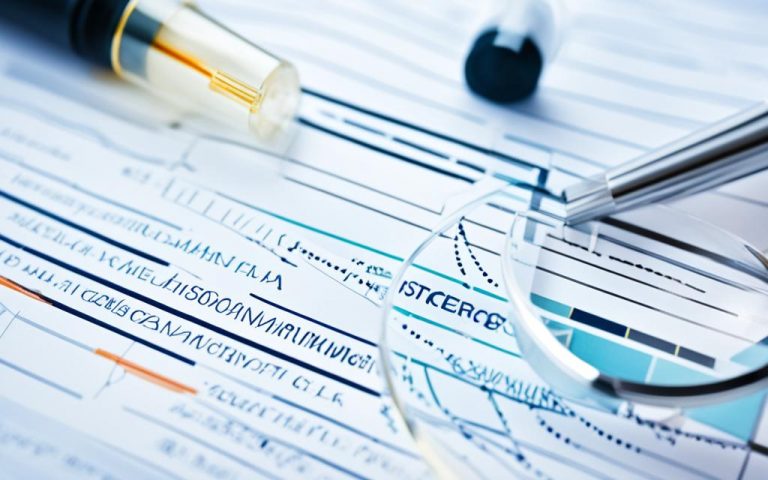Optimizing Nutrition: Your After Chemo Diet Guide
Recovering from cancer treatment means being strong and smart about what you eat. Having the right after chemo diet is key for getting better. This guide gives you the info you need on nutrition after cancer treatment. It will help you renew strength with balanced nutrition. Learn how changing what you eat can make a big difference in feeling good after chemo.
Key Takeaways
- Understand the integral role of nutrition in post-chemotherapy recovery.
- Learn how an after chemo diet can help rebuild and fortify your body.
- Discover the essentials of balanced nutrition tailored for cancer recovery.
- Access practical tips and meal ideas that cater to your new dietary needs.
- Gain insights into managing side effects through informed food choices.
Understanding the Importance of Nutrition After Chemotherapy
After your chemotherapy, the road to getting better includes more than just doctor’s care. What you eat plays a big role in your recovery. Good nutrition helps your body fix itself and fight off the lasting effects of tough treatments.
Starting a healthy diet after chemotherapy is crucial. It strengthens your immune system, which chemotherapy might have weakened. Eating right can ease side effects like tiredness and lower infection risks. It provides what your body needs to recover quicker and easier.
- A variety of fresh, whole foods can refurbish essential nutrients.
- Lean proteins help repair tissue damages induced by chemotherapy.
- Antioxidant-rich fruits and vegetables can attenuate oxidative stress.
Now, it’s time to focus on eating right to help your cells fix themselves and boost your energy. A healthy diet after chemo helps your body heal not just on the outside, but all the way to the cellular level.
Each person’s diet may vary after chemo, depending on their health and specific needs. Yet, the main idea stays the same: to eat in a way that builds strength and helps your health bounce back. Getting good post-chemo nutrition is key to starting a new, healthier phase in your life.
Essentials of an After Chemo Diet
After chemotherapy, paying close attention to what you eat is crucial. Your diet helps recover and nurture your body. This section looks at the key parts of a good post-chemo diet. It covers nourishing foods, drinking enough water, and eating the right amounts of macros and micronutrients.
Nourishing Foods After Chemotherapy
Choosing the right nourishing foods after chemotherapy is vital for recovery and getting stronger. Foods loaded with vitamins, minerals, and antioxidants fight the harm chemotherapy can cause. Eating a mix of fruits, vegetables, lean proteins, and whole grains helps a lot.
Hydration: The Cornerstone of Recovery
Keeping hydrated is key to recovery. Water cleans out toxins, helps absorb nutrients, and keeps your body’s tissues healthy. Drinking plenty maintains your body’s functions and can ease chemotherapy side effects like nausea and tiredness.
Managing Macro and Micronutrient Intake
It’s important to know and manage your intake of macros and micronutrients for rebuilding strength. Proteins, carbohydrates, and fats are all crucial. Proteins repair cells, carbs give energy, and fats can lessen inflammation. Here’s a table showing recommended meal choices after chemotherapy to help your recovery.
| Food Type | Benefits | Examples |
|---|---|---|
| Proteins | Supports cell repair and immune function | Chicken, Fish, Legumes |
| Carbohydrates | Provides energy | Whole grains, Fruits, Vegetables |
| Fats | Reduces inflammation, supports cell growth | Avocado, Nuts, Olive oil |
| Vitamins & Minerals | Facilitates overall body functions and recovery | Leafy greens, Berries, Citrus fruits |
How to Identify Nutrient-Dense Meal Choices After Chemotherapy
After chemotherapy, it’s vital to focus on nutrient-dense meal choices. These meals are rich in vitamins and minerals. They’re also gentle on your stomach and boost your energy. Here’s a guide to picking the best foods for healing and feeling lively.
Understanding which foods offer great nutrition without upsetting your stomach is key after treatment. Here are simple dietary tips to help plan your meals:
- Include a variety of colors in your meals: Bright fruits and veggies are full of nutrients.
- Opt for whole grains: Quinoa, oatmeal, and brown rice have B vitamins and fiber for a healthy energy level.
- Lean proteins are key: Add lean meats, fish, eggs, and legumes for muscle repair and immune support.
- Healthy fats: Avocados, nuts, seeds, and olive oil are great for nutrient absorption and cell health.
Nutrient-dense meal choices mean more than just eating healthy. They require thoughtful decisions that match your body’s needs after chemotherapy. Here’s how to combine these foods effectively:
| Food Category | Examples | Benefits |
|---|---|---|
| Fruits | Berries, citrus fruits, apples | Rich in vitamins, antioxidants, and fiber |
| Vegetables | Broccoli, spinach, carrots | High in vitamins and minerals |
| Whole Grains | Whole grain bread, brown rice | Provides sustainable energy |
| Proteins | Chicken breast, lentils, tofu | Essential for tissue repair and growth |
| Fats | Olives, nuts, seeds | Supports cell growth, hormone production |
Adding these nutrient-dense meal choices to your diet helps your recovery. Listen to your body and adjust your diet as needed. Remember, getting the right nutrition is a big part of your health journey post-chemotherapy.
The Role of Dietary Supplements in Your Post-Chemo Eating Plan
Adding dietary supplements to your post-chemo eating plan can greatly aid your recovery. They help refill your body with the nutrients it lost during treatment. The idea of including supplements might seem like a lot. But with the right guidance and choices, supplements can greatly aid in your recovery.
When to Consider Vitamin and Mineral Supplements
Your body needs more vitamins and minerals after chemotherapy. Supplements can provide the extra nutrition your diet might not cover. If you feel tired, get sick often, or heal slowly, your body may need more nutrients. Always talk to a healthcare provider before starting supplements to make sure they’re right for you.
Interactions Between Supplements and Chemo Drugs
It’s important to know how supplements might affect your chemo drugs. Some can change how your medications work, which could cause problems. For example, too much Vitamin E or C might reduce the effectiveness of some chemo drugs. Discuss your supplement plans with an oncologist to avoid any risks.
- Consult your oncologist before adding supplements to your regimen.
- Consider supplements that address specific symptoms you are experiencing.
- Review and monitor the interaction of supplements with ongoing treatments.
Make sure to have your healthcare team’s guidance before adding supplements to your diet. Supplements work best when part of overall post-cancer care. This care should also include a balanced diet, exercise, and good sleep. Together, these steps can help you on your recovery journey.
Foods to Include and Avoid in Your After Chemo Diet
Recovering from chemotherapy requires a good diet plan. It’s important to know which foods after chemotherapy help you heal. And which ones to stay away from. This advice is meant to help you make better decisions about nutrition after cancer treatment. It aims to improve your recovery and health overall.
- Include: Fruits and Vegetables – They are full of vitamins, minerals, and fibers that boost your immune system. Try to eat many different colors to get lots of nutrients.
- Include: Lean Proteins – They are key for the healing and rebuilding of tissues after chemotherapy. Good sources include chicken, fish, eggs, and legumes.
- Include: Whole Grains – Foods like quinoa, brown rice, and oats give you necessary energy. Plus, they are easy on your stomach.
- Avoid: Raw and Undercooked Foods – They have a high infection risk, which is dangerous with a weakened immune system.
- Avoid: Sugary and Highly Processed Foods – These can make your energy levels spike and then crash. They don’t provide the nutrition you need.
- Avoid: Excessive Dairy Intake – Post-chemotherapy, if you become lactose intolerant, limit dairy or choose lactose-free options.
It’s very important to eat foods after chemotherapy that aid healing and avoid those that could slow your recovery. Making these smart choices can greatly affect your recovery speed and life quality after treatment.
Crafting a Balanced Healthy Diet Post-Chemo
After cancer treatment, getting healthy isn’t just about healing from side effects. It’s about eating right to help your body recover and stay well. Healthy diet post-chemo is key to a better life after treatment. Here you’ll find tips on making a diet that has balanced nutrition after cancer treatment. Such a diet will help you get stronger and healthier.
Building a Well-rounded Plate
A healthy diet post-chemo needs a mix of all food types at each meal:
- Proteins: They’re key for healing and making new body tissue. Eat things like lean meats, beans, and tofu.
- Carbohydrates: They give you energy. Pick whole grains like oats, quinoa, and whole wheat bread.
- Fats: Needed for growing new cells. Get healthy fats from foods like avocados, nuts, and seeds.
- Fruits and Vegetables: Full of vitamins, minerals, and fiber. Try to eat many different colors.
By eating from each group, you get all the nutrients your body needs to heal and to boost your immune system.
Meal Timing and Frequency for Optimal Results
What, when, and how often you eat is big for recovery. Eating at regular times keeps your energy up and helps your health. Tips include:
- Eat small meals throughout the day to keep energy steady.
- Start with a nutritious breakfast to meet your body’s healing needs.
- Have regular, balanced snacks between meals to control hunger and keep blood sugar stable.
Sticking to a schedule can help your body recover better. Making balanced nutrition after cancer treatment a daily part of life is important, not just something you think about sometimes.
Recipes for Chemo Recovery: Easy and Nutritious Ideas
After chemotherapy, getting back to your normal diet can be hard. Recipes for chemo recovery are key. They should be both nutritious and simple to make. These meals help build your strength and improve your health after treatment.
Simple Home Cooking for Strength and Wellness
Cooking at home can boost your nutrition. These meals meet your specific needs. They’re made to be gentle but rich in nutrients. The goal is to make cooking easier and make your diet nutrient-rich.
- Broth-based soups with soft cooked vegetables and lean proteins
- Smoothies made with Greek yogurt, fruits, and a handful of spinach or kale
- Soft-cooked whole grains like oatmeal or congee, which are gentle on the stomach
Quick Snack Recipes for Energy Boosts
Snacking is crucial in chemo recovery. Snacks are small energy boosts. They are more important when you’re not feeling hungry.
- Almond butter and banana on whole-grain toast
- Homemade granola bars with oats, nuts, seeds, and dried fruit
- Cottage cheese with soft fruits such as peaches or pears

The chosen meal choices after chemotherapy boost energy. They also offer various textures and flavors. These can help with taste changes from treatment.
| Meal Type | Ingredients | Preparation Time |
|---|---|---|
| Breakfast | Oatmeal, almond milk, banana slices | 15 mins |
| Lunch | Quinoa salad with cucumber, cherry tomatoes, feta cheese, olive oil dressing | 20 mins |
| Dinner | Grilled chicken breast, steamed broccoli, sweet potato mash | 30 mins |
| Snacks | Yogurt parfait with granola and mixed berries | 10 mins |
These tasty yet simple recipes for chemo recovery are great for healing. They are easy to digest and to make. They help you keep a healthy diet during and after chemo recovery.
Adjusting Your Diet for Specific Post-Chemo Needs
After chemo, it’s vital to adapt your diet for your recovery journey. Each person has different challenges after treatment. This means following a tailored nutrition after cancer treatment plan is essential. It should consider side effects, any health conditions like diabetes, or just overall well-being. A customized post-chemo eating plan can lead to better health results.
To effectively change your eating habits, you need to know about helpful nutrients and which foods to avoid. Here’s a basic guide to adjusting your diet for your post-chemo nutritional needs:
- Monitor Sodium Intake: This is important for managing blood pressure after chemo.
- Increase Fiber-Rich Foods: Good for fixing digestive issues caused by chemotherapy.
- Manage Blood Sugar: For those with diabetes, it’s crucial. Choose meals that are balanced and have a low glycemic index.
It’s also wise to consider working with a dietitian who knows about tailored nutrition after cancer treatment. They can create a food plan that meets your specific needs. Plus, they’ll ensure it fits your lifestyle and tastes, making your recovery smoother and more pleasant.
| Condition | Recommended Adjustment |
|---|---|
| High Blood Pressure | Low sodium, balanced potassium intake |
| Weight Management | Increased protein, controlled portion sizes |
| Diabetes | Low glycemic index foods, frequent small meals |
With these custom tweaks to your post-chemo eating plan, you can better handle side effects and speed up recovery. Every little adjustment makes a big difference in your health. This shows how important tailored nutrition after cancer treatment is.
Taking Control of Your Diet: Post-Chemo Nutrition Advice
After cancer treatment, taking charge of what you eat can be very empowering. It’s crucial to get post-chemo nutrition advice tailored for you. This advice helps deal with your body’s changes. Here are some dietary tips after cancer treatment focused on your health and wellness.
It’s important to know which foods can rebuild your body and boost your energy. Eating a variety of nutrient-rich foods gets you the vitamins and minerals you need. These play a big part in your recovery. Try these dietary tips in your daily meals:
- Include plenty of proteins to aid tissue repair and muscle growth.
- Choose whole grains over refined grains to provide sustained energy.
- Eat a colorful array of fruits and vegetables to maximize intake of antioxidants.
- Stay hydrated; water is pivotal for healing and energy.
| Meal Time | Food Type | Examples |
|---|---|---|
| Breakfast | Protein + Whole Grain | Scrambled eggs with spinach on whole-grain toast |
| Lunch | Lean Protein + Vegetables | Grilled chicken salad with a variety of vegetables |
| Dinner | Whole Grain + Vegetables + Healthy Fat | Quinoa bowl with mixed veggies and avocado |
| Snacks | Fruit + Protein | Greek yogurt with berries |
After chemo, eating right is more than just food choices; it’s how you eat too. Eating smaller meals more often may help with nausea or a low appetite. Each diet step helps you get stronger and healthier.
Use this post-chemo nutrition advice to make smart food choices. Your diet is key to regaining health, giving you control over your recovery with every meal and bite.
Easing Digestive Discomfort with Targeted Meal Choices After Chemotherapy
After chemo, many suffer from gut discomfort. Luckily, picking the right meals and eating habits can help. You can ease these troubles by choosing wisely.
Anti-inflammatory Foods to Soothe Digestion
Eating anti-inflammatory foods is key after chemo. Foods like salmon, flaxseeds, and walnuts are rich in omega-3. They help fight inflammation. Also, spinach, kale, berries, and turmeric are good for your gut. These choices aid in reducing swelling and support health recovery.
Strategic Eating Habits to Reduce Gastrointestinal Issues
It’s also crucial to eat smart. Having small meals often helps keep digestion smooth. This avoids overwhelming your gut. Eat easy-to-digest foods like bananas, rice, applesauce, toast to fight nausea and bloating. Drinking plenty of fluids is crucial for digestion and getting rid of toxins.
It’s all about balancing nutrition to fight chemo’s side effects on your gut. A nutritionist can offer advice tailored to your needs. They compliment these general tips, ensuring your meal choices fit your health requirements.
Navigating Eating Challenges Post-Chemotherapy
After chemo, adjusting your diet can be tough. You may face issues like taste changes, dry mouth, and swallowing difficulties. These tips can help you enjoy meals that are both nourishing and tasty.
Enhancing flavors and managing taste alterations are key since many face a metallic taste or no flavor in food. Try adding herbs, spices, or citrus zest to improve flavor. For dry mouth, opt for moist foods and smoothies.
Below is a table with eating challenges and foods that can help:
| Challenge | Foods to Consider |
|---|---|
| Changes in Taste | Fruit smoothies, ginger tea |
| Dry Mouth | Broths, mashed vegetables |
| Difficulty Swallowing | Oatmeal, scrambled eggs |
| Nausea | Crackers, bananas |
Your post-chemo eating plan aims to foster long-term health. You will find the right food balance to overcome challenges and aid recovery.
Practical Dietary Tips After Cancer Treatment
After cancer treatment, adopting the right dietary tips is key to recovery and lasting health. It’s important to eat right to improve your well-being. Here are some tips on how to manage your diet and keep a healthy kitchen.
Maintaining a Clean and Safe Kitchen Environment
Keeping your kitchen clean is vital to lower infection risks. Use antibacterial cleaners on surfaces and wash dishcloths and sponges often. This stops bacteria from growing. Make sure to store raw and cooked foods separately to stop cross-contamination.
Smart Grocery Shopping and Label Reading
Choosing the right foods when grocery shopping is important. Pick fresh fruits, vegetables, and lean proteins. Stay away from food high in preservatives and artificial stuff. Pay attention to labels. Aim for foods low in sodium and sugar but rich in vitamins and minerals.
| Category | What to Look For | What to Avoid |
|---|---|---|
| Fruits and Vegetables | Fresh, frozen, or low sodium canned options | Canned items with added sugars or syrups |
| Proteins | Lean meats, fish, beans, and legumes | Red meat and processed meats high in sodium |
| Dairy | Low-fat milk, yogurt, and cheese | High-fat dairy products |
| Snacks | Nuts, seeds, and whole-grain products | Snacks that are high in refined sugars and fats |
Adding these dietary tips to your routine after cancer treatment helps your recovery. It’s not only about eating healthy but also making sure your food is safe and shopping smart.
Dealing with Appetite Loss: Recipes for Chemo Recovery
Appetite loss is common during chemo recovery. Crafting a diet that boosts appetite and provides essential nutrition is crucial. We focus on recipes for chemo recovery made to tackle this problem.
When appetite is low, every bite is key. So, we aim to fill each meal or snack with lots of nutrition. Here, you’ll find recipes that are tasty, easy to make, and simple to eat. They help a lot in managing appetite loss post-chemo.
- Smoothies: Full of vitamins and minerals, smoothies offer nutrition in just a few sips. They are great for combatting nausea.
- Stews and Soups: Soothing and gentle, they pack nutrition when made with veggies, lean meats or beans, and mild spices.
- Energy Bites: Made with nuts, oats, and dried fruits, these small snacks are easy to eat. Plus, they’re handy for on-the-go snacking.
These recipes for chemo recovery suit small appetites and are key for your recovery diet. Opt for small, frequent meals if big ones are too much.
| Meal Type | Ingredients | Nutritional Benefits |
|---|---|---|
| Smoothie | Banana, spinach, protein powder, almond milk | Loaded with protein, vitamins A and C, and calcium |
| Stew | Chicken, carrots, potatoes, celery | Packed with protein and fiber, boosts energy |
| Energy Bite | Almonds, dates, coconut flakes, cocoa powder | A great source of healthy fats, iron, and antioxidants |
Adding these special recipes for chemo recovery to your diet helps a lot in managing appetite loss post-chemo. It’s key to make your meals tasty and rich in nutrients for your recovery and health.
After Chemo Diet: How to Stay Motivated and Committed
Starting a diet after chemo is key for getting better and staying healthy. However, it’s not always easy to keep up the motivation. In this part, we’ll talk about how to stay on track with your post-chemo eating plan. We’ll look at the benefits of support systems and how setting goals can help.
Finding Support and Accountability in Nutrition
It’s crucial to have a strong support network when following a post-chemo diet. You should try to connect with dietitians who know about post-chemo diets. Or, you can be part of groups that share recipes and stories. Talking about your journey with others can really help keep you motivated.
- Engage with online communities that focus on cancer recovery and nutrition.
- Involve family and friends in your diet plans. Cooking together can be fun and supportive.
Setting Realistic Goals and Celebrating Milestones
Being excited about your diet after chemo means setting goals that you can reach. Start with small changes in what you eat. Then, add more healthy foods little by little. Don’t forget to celebrate your achievements, no matter if they’re big or small. This really helps with staying focused and happy.
- Set weekly goals, like adding fruits and vegetables to your meals.
- When you reach a goal, treat yourself. Maybe read a new book or enjoy a movie night.
In the end, staying motivated with your diet after chemo depends on both yourself and others. Goals you set for yourself and the support you get are important. By working on these aspects, you’ll have a more successful and enjoyable journey towards feeling better and well-being.
Conclusion
The journey after chemotherapy is tough. But it’s about more than just handling symptoms and visits to the doctor. It’s about taking real steps to get your health back with a good diet after chemo. As this guide has shown, getting strong again with the right food is not just a hope. It’s something you can really do with the right knowledge and tools.
A diet full of nutrients that help you heal is key. We showed how important it is to eat the right foods for recovery. We talked about why staying hydrated matters, and how the right mix of nutrients is needed. We also looked at how supplements can fit into your health plan. Plus, we gave tips on choosing foods that make you feel better if you have stomach issues. Eating right, even when it’s hard, helps you stick to your health goals as you get better.
Everyone’s recovery path after chemo is different. But by choosing to follow a diet that meets your needs, you’re building a foundation for a healthier future. Making good food choices helps bring back your strength through nutrition. By focusing on your diet, you’re a key player in your own recovery. You’re rebuilding yourself and growing stronger. Cheers to moving forward towards a vibrant and healthy life.
FAQ
Why is nutrition important after chemotherapy?
Nutrition boosts repair in your body after chemo. It rebuilds tissue and strengthens your immune system for recovery. A well-chosen diet lessens chemo side effects and uplifts life quality post-treatment.
What foods are considered nourishing after chemotherapy?
After chemo, eat vitamin-rich fruits and veggies, lean proteins for repair, and whole grains for energy. Don’t forget healthy fats to reduce swelling. Also, drinking plenty of water and herbal teas is key.
How can I manage my macro and micronutrient intake post-chemo?
Eat various foods for a balanced diet. This way, you’ll get enough carbs, proteins, fats, vitamins, and minerals. If you’re unsure, a dietitian can create a plan for you, considering any chemo side effects.
Are there any dietary supplements I should consider after chemotherapy?
Some might need extra nutrition from supplements after chemo. But always talk to your doctor first. They’ll make sure these supplements are safe with your meds.
What are the best meal choices after chemotherapy for optimal health?
Choose meals that are full of nutrients yet easy to digest. Think smoothies, soups, steamed veggies, and lean meats. Stay away from junk food, too much sugar, and heavy fats to keep your stomach happy.
How should I craft a balanced, healthy diet post-chemo?
Your diet should be varied, including something from all food types. Half your plate should have fruits and veggies. A quarter should be whole grains, and another quarter lean proteins. Adjust when and how much you eat based on how you feel.
What recipes can help with chemo recovery?
Look for simple and healthy recipes. Try mild protein shakes, vegetable stews, or homemade granola bars. A dietitian can help tailor recipes to meet your needs and taste preferences.
How can my after chemo diet be adjusted for my specific needs?
Your diet may need tweaks based on your side effects or health goals. A professional can guide you on what foods to eat more or avoid. Together, you’ll create a diet plan suited to your nutritional needs and symptom management.
What can I do to ease digestive discomfort after chemotherapy?
To lessen tummy troubles, eat foods that calm inflammation, like ginger and peppermint. Have small meals often and chew well. Choose stomach-friendly foods and avoid caffeine, spice, and fatty foods.
How do I deal with changes in taste after chemotherapy?
Try different spices, herbs, and sauces to find what works for you. If you get a metallic taste, plastic utensils might help. Lemon juice can improve taste, and rinsing your mouth before meals might help too.
What are some practical dietary tips to follow after cancer treatment?
Keep your kitchen clean to avoid infection. Choose fresh foods and read labels to dodge extra sugar and fats. Planning your meals can help you keep a balanced and varied diet during recovery.
How can I manage appetite loss during my chemo recovery?
Eat little but often, and pick calorie-rich and nutritious foods. Opt for appealing textures and flavors. Smoothies or shakes are great for when you don’t feel like eating solid food.
How can I stay motivated to follow my after chemo diet?
Staying on track can be hard. Set small, reachable goals and seek support from loved ones or a nutritionist. Celebrate every success. Remember, these changes are important for your health and healing.







